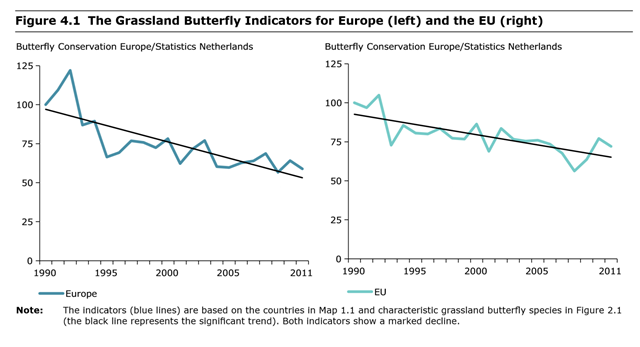Graph of the Day: Decline of butterfly populations in Europe and EU, 1990-2011
22 July 2013 (EEA) – The European Grassland Butterfly Indicator has been updated both for Europe and the EU. In this chapter both indicators are presented. Figure 4.1 shows the European Grassland Butterfly Indicator, as well as the indicator for the Member States of the EU alone. The indicator is based on the supranational species trends as presented in Chapter 3. As in previous versions, both indicators showed a marked decline between 1990 and 2011. Compared to 1990, the European populations of the 17 indicator species have declined by, on average, almost 50 %. The decline seems to have slowed a little in the last few years. The negative trend in the EU Member States alone is a little less than in Europe as a whole, with a decline of almost 30 % over the period. When interpreting these graphs it should be remembered that a large decline of butterflies in north‑western Europe (countries all already in the EU for a long time) happened before 1990. So far, 2008 and 2009 were the worst years for these butterflies, both on a European and EU scale, but 2010 and 2011 showed a slight recovery, especially in western Europe. These good years might be attributed to weather conditions, but they do not compensate for the steady loss in previous years. The European Grassland Butterfly Indicator shows that butterfly numbers on grasslands have decreased by almost 50 %. What does this mean for Europe’s biodiversity? The European Grassland Butterfly Indicator shows a clear negative trend (see Figure 4.1). The indicator shows that since 1990 butterfly populations have declined by almost 50 %. Although in 2010 and 2011 some populations showed a slight recovery, the declining trend identified in the first versions of this indicator in 2005, 2008 and 2010 has continued (van Swaay and van Strien, 2005 and 2008; van Swaay et al., 2010b). This shows that butterflies are still disappearing from Europe’s grasslands. This huge decline has important implications for the conservation of biodiversity because butterflies are considered to be representative indicators of trends.
5 Implications observed for most other terrestrial insects, which together form around two thirds of the world’s species (Thomas, 2005). Butterflies are therefore useful biodiversity indicators — for example, in evaluating progress towards achieving the EU target of halting biodiversity loss (EEA, 2012). Butterflies appeal both to the general public and decision‑makers (Kühn et al., 2008). They are also fairly easy to recognise and therefore data on butterflies have been collected for many years and by thousands of voluntary observers. The method for monitoring butterflies is well described, extensively tested and scientifically sound (Pollard, 1977; Pollard and Yates, 1993; van Swaay et al., 2008a). As a result, butterflies are the only invertebrate taxon for which it is currently possible to estimate rates of decline among terrestrial insects (de Heer et al., 2005; Thomas, 2005).
The European Grassland Butterfly Indicator: 1990–2011
